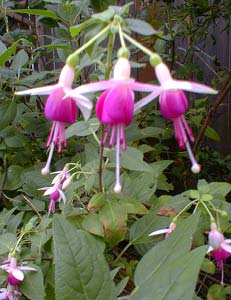
Queen Esther's
Ladies' Eardrops
"And it blew a color, bright as the bloom
Of the pinkest fuchsia's tossing plume."
-Nora Perry
(1832-1896)
(1832-1896)
One of the fancier of the temperate garden-hardy fuchsias, 'Queen Esther' adapts to considerable heat or cold, blooming with a near ferocity with white sepals surrounding a deep violet or magenta corolla that is wholly visible.
It approaches the ornateness of the delicate basket varieties, though still a single & not excessively gaudy. It begins blooming in July & is still blooming in November, mild frosts barely slowing it down.
Though evergreen through most of our temperate winters, which never reach the ten degrees F. that would cause complete die-back, it nevertheless looks pretty beaten up by winter's end & needs a serious pre-spring pruning to make room for new growth.
But every now & then we have a winter cold-snap with temperatures in the lower twenties & into the teens, usually lasting no longer than a week, & this causes 'Queen Esther' to die to the ground, so in our climate it never quite has the chance to build up a wood structure, as it could further south. In late 2003, we had a long-lasting cold-snap that killed several on-the-margin perennials, including 'Queen Esther,' though I suspect it would have survived had it been planted against the house for residual warmth.
The mature plant reaches about three feet of height, & a bit wider. It made a good companion with a White Bleedingheart ( Dicentra spectabilis var alba) because when the bleedingheart got thin at the height of summer, 'Queen Esther' held the spot's interest on her own.
It is certainly appropriate that Queen Esther should have a fuchsia named for her, since she was well-famed for her garden. So too Esther is represented by a shining star in heaven, or by a star-shaped flower. She dwelt in the Persian Citadel of Susa or Shushan, which means "Lily" or "Lotus," & alludes to the Goddess en-Susinak, just as Esther's name alludes to Ishtar-Inanna, who gave birth to all plantlife at the climax of the tale of the "Descent of Inanna."
Even the great Jewish sages admit that her name is one & the same with Ishtar's [Megillah 13a], & the unknown author of the "Additions to Esther" identified her as a river-goddess [Ad Est 10:6]. Her Hebrew name is Hadassah, a flowering myrtle bush, which was sacred to Aphrodite who covered herself with myrtle branches when She first stepped out of the sea. Because Isaiah compared evil transformed into goodness to briars transformed into myrtle [Isa 55:13] it is said that Zeresh the evil wife of Haman was the briar and Esther the myrtle; but their natures are borrowed from the mythology of Innana & her dark sister Ereshkigal, Queen of Darkness.
Esther's Garden originally belonged to Queen Vashti [Est 1:4], but it was later the place to which the King withdrew in order to permit Queen Esther to make decisions from the Throne [7:6]. The phrase "Queen Esther's Garden" came to mean a place of treasures, & these treasures were not merely gold & jewels, but also wisdom & poetry & beauty of spirit.
Today, during Purim, the holiday of Queen Esther, people give flowers to their loved ones, for when Esther first established the holiday of Purim, a seven-day banquet was held in her garden. She had to continue the banquet for so long in order that she could feed all the people who dwelt within the Citadel of Susa.
Esther's garden banquet was the Feast of Wisdom, & was the reverse of a similar seven-day banquet held by the king before Esther was crowned, at which the king & princes became drunken & attempted to destroy the reputation of Queen Vashti [1:5], this having been the Feast of Folly.